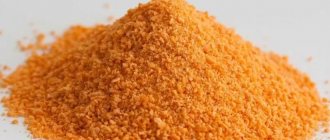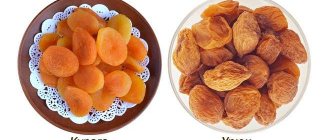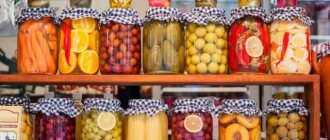About thirty years ago it was quite difficult to find food in stores. It was not possible to buy everything and not always. Times were difficult, so our grandparents, mothers and fathers had to somehow get out of the current situation. Home canning was popularized during Soviet times. But even now, when you can buy vegetables and fruits, including exotic ones, in the supermarket at any time of the year, housewives continue to preserve the gifts of the garden. Why? After all, the need to stock up for the winter has long ceased? Because it's delicious! And this is the main argument in favor of homemade preparations.
However, it is not enough to simply preserve rosy tomatoes, crispy cucumbers and amazingly aromatic berry jams. You need to learn how to store them correctly. Otherwise, all your work will go to waste. Today we will talk about where it is best to store jars of provisions and how long you can do this.
Stewed meat, pickles, preservation: features of food storage
There are fairly universal rules for storing jars of homemade ingredients. However, depending on the technology for preparing canned food, there are some nuances that housewives should be aware of.
- Thermally processed and preserved vegetable product. Example: pickled tomatoes, lecho under a tin lid, squash caviar sealed in a jar using a special key, and so on. If the product, before being preserved, underwent heat treatment (scalded, boiled or stewed), and then was preserved under a tin lid, and not just covered with a nylon lid, then the conditions for its further storage should be as follows: the temperature should be about 20 degrees, and the humidity level should be around 75%.
- Pickled and salted vegetables and fruits. Sauerkraut, salted watermelons (not canned), soaked apples are stored in the refrigerator or cellar (or in any other suitable place) provided that the temperature in this room is in the range from zero to four degrees Celsius.
- Mushrooms and meat products. If you have preserved the gifts of the forest, for example, boletus, cranberries or blueberries collected in a forest clearing, store such jars at a temperature of three to eight degrees Celsius. The same rule applies to canning meat products. For example, stews.
But what is strictly prohibited in this case is storing the workpieces at sub-zero temperatures. Of course, you can try, but don't count on a positive result. Firstly, frozen berries and vegetables, after defrosting, will lose their visual appeal and significantly lose their taste. And that's the best case scenario. Because in the worst case, the jar will simply burst and crumble into small pieces, since when frozen, the liquid inside the glass container expands and simply breaks the glass.
If the jar bursts, you should definitely not eat its contents. Firstly, a small fragment may get into the food, which is invisible to the naked eye. And secondly, brines and marinades freeze at minimal sub-zero temperatures. When frozen, the seal of the jar is broken, bacteria penetrate there and immediately begin to multiply, making the product dangerous to humans.
Tomatoes and cucumbers
It is generally accepted that pickled and pickled cucumbers, as well as tomatoes, retain their taste and remain safe for health for 2 years. However, it is advisable to eat them in the first year if:
- the jars are closed with not very tight nylon lids;
- sterilization was carried out by pouring boiling water twice, rather than keeping it in a pan of boiling water;
- a modified proportion of salt, sugar or vinegar was used.
Canned tomatoes and cucumbers that are pressure sterilized in an autoclave can be stored for 3-4 years.
A secluded place: where is the best place to put home preserves?
Usually, in order to store homemade preparations, housewives use either a cellar or a pantry. Often jars of preserved food are stored in the garage, if there is one. But even if the owner has neither a garage nor a cellar at her disposal, she always finds a secluded corner in the apartment.
Cellar
If you live in a private house, then you probably have a underground floor - like our ancestors. A room under the house is a great place to store cans of canned food. In particular, because the microclimate of the cellar meets the requirements stated above, that is, temperature and humidity levels.
- To be completely sure that the jars will not freeze, sometimes it is necessary to insulate the underground from the inside.
- In order for the process of storing homemade products to comply as much as possible with generally accepted norms and rules, it is necessary to improve the ventilation in the basement.
- To prevent fungus from growing in the cellar, and to prevent mold from creeping along the walls and shelves on which the jars stand, the internal surfaces of the subfloor must be regularly (once or twice a year) treated with copper sulfate.
In principle, if in the cellar you only store jars sealed with tin lids, they are not afraid of mold. But if there are containers with nylon lids in the underground, under which pickles and meat products (for example, salted lard or sauerkraut) are waiting in the wings, processing must be carried out. Otherwise, the fungus will penetrate inside and create pathogenic flora inside the glass container.
Copper sulfate is not the only means for treating the internal surfaces of the cellar. A solution of bleach, which you probably have on hand, also copes well with this task.
Apartment
Finding a place to store canned goods in a city apartment is a big question. It all depends on whether your apartment has a balcony. Or maybe there is a loggia instead of a balcony? Or at least a small storage room? Some houses have special niches under the kitchen window sill, made specifically for orderly storing jars of cucumbers and tomatoes. We will talk about storing cans on the balcony separately. In the meantime, let’s discuss the available places for storing preserves if there is no balcony in the house.
- Preservation should not be exposed to the sun's rays, so the place where the jars are stored should be dark. The role of such a location can be played by a kitchen cabinet with doors, remote from the heating radiator.
- If the apartment does not have a storage room, you can make a cabinet yourself using drywall and hinged doors. The optimal width is slightly larger than the diameter of a three-liter jar. Therefore, the cabinet will be quite narrow. Look around: there is probably a good place for it in your apartment.
- Pickled vegetables can be stored on the mezzanine, if you have one in your apartment. As a last resort, they can be placed behind the sofa or under the bed. The main thing is to stay away from the heating system.
As for pickles and meat products sealed under a tin lid, it is better to send them to the bottom shelf of the refrigerator.
Balcony
If the apartment has a balcony, all issues related to storing cans of preserves are immediately eliminated. You can install a rack on the balcony, equip it with hinged doors or a bamboo curtain that rises up and, if necessary, moves down, and put all the cans you have in stock there.
- If there is a radiator on the balcony, it is very important that it has a temperature regulator or shut-off valve so that you can regulate the microclimate in the room.
- You cannot store jars on an unglazed balcony during the winter. Why - we already wrote above when we talked about how low temperatures affect the contents of glass containers.
- The balcony is often used for drying clothes. Try to either not dry your clothes on the balcony at all in winter by purchasing a special dryer and installing it in the room, or constantly ventilate the room so that it is not too humid.
- Do not store fermented foods on the balcony during cold and hot periods. At this time, it is better to put them in the refrigerator.
Thermal insulation is the only, but mandatory, condition for storing preserved food on the balcony during the frosty season.
Labeling on packaging
According to clause 4.6. GOST R 51074-2003 manufacturers are required to place the following information about the product on the paper label:
- name (trademark or sign) and grade;
- information about the manufacturer or person authorized to accept claims regarding product quality in Russia;
- weight (net, in grams);
- data on quality compliance with regulatory documents (for example, GOSTs);
- nutritional value and composition;
- storage conditions (requirements for temperature and humidity must be indicated);
- shelf life;
- expiration dates;
- date of manufacture of the product.
The label must be readable, without damage, all information is indicated only in Russian.
Manufacturers often place information about the shelf life of the product on the lid, applying it using lithography or special paint. This is done on the surface limited by the first bomb ring, and a special instruction for the consumer is written on a paper label.
The marking is deciphered as follows:
- the first row of numbers indicates the day, month and year of production;
- second row – assortment mark and digital identifier of the manufacturer;
- the third row is the shift number and the index “P”, indicating the fishing industry.
Preservation storage period
Fresh vegetables and fruits contain the maximum amount of vitamins and minerals. You probably know this truth, so we repeat it just in case. If you couldn’t eat vegetables fresh or if your household can’t imagine life without your preparations, be sure to can them. However, there is one problem: it is extremely difficult to guess how many cans will be eaten over the winter. Rarely does anyone succeed. Therefore, jams and pickles often sit in the back of the pantry for several years on end. But each product has its own shelf life!
Canned meat
Meat products of domestic origin should be stored for no longer than 12 months. And even then only under the condition of unquestioningly following the rules for storing such provisions. In a good way, knowing the current Ukrainian realities and how you and I ignore the recommendations of experts, it is better to eat canned meat within six months. In addition, when preparing stew, you need to remember that the minimum heat treatment period for meat is at least 120 minutes.
Pickles, pickled and pickled products
Lactic acid fermentation, which occurs in sauerkraut, pickled apples and other fruits prepared by salting, pickling or soaking, dictates our preservation shelf life.
- If products are kept in a temperature range between 0 and 4 degrees Celsius, their shelf life is ten months.
- If the products are stored in conditions of 10 degrees Celsius (plus/minus), then the period is significantly reduced: 9 months turn into 3 months - during this time the preparations should be eaten. And if you don’t have time, throw it away.
Please note: when removing vegetables or berries from jars, you should use only clean cutlery. It is advisable to keep the jar open as little as possible. This way, the quality of its content will remain at a high level longer.
Marinated foods and mushrooms
Everything we love, from lecho and squash caviar to pickled honey mushrooms, can be stored for a maximum of 18 months. The vinegar and citric acid present in such dishes allow them to retain their freshness longer than others. If there is very little vinegar or lemon in the composition, and you know about it, try to eat the preparation within a year.
Mushrooms and forest products are a different story. The maximum shelf life of such products is ten months. It’s better not to leave pickled boletus next year. Even if you really want to. Don't skimp on food, health is more important.
Compotes and berry drinks
The answer to the question of how long compotes are stored depends on what berries or fruits are the ingredients of your canned drinks.
- Compotes from stone fruits can be stored for no more than a year.
- Compotes made from berries without seeds can be stored for up to one and a half years.
In order to quickly understand which jar was preserved this year and which was preserved in the past, we recommend that you put special stickers on the glass container indicating the date of manufacture.
Bones from berries and fruits must be removed when canning. The bone contains a substance called amygdalin. During long-term storage, amygdalin turns into hydrocyanic acid, which is harmful to health.
Shelf life of canned food after opening the can
What is the shelf life of opened cans? Canned meat in metal containers can be stored for two days. In a glass jar - seven days. But there is a way to increase the storage duration.
To do this, you will need to transfer the top layer of fat to another bowl. Afterwards, take out the required amount of meat and pour the melted fat over the remaining product. Then cover the jar with a lid and keep it on the top shelf of the refrigerator. This method of re-canning allows you to extend the shelf life up to five months.
Uneaten leftover stew can be frozen by transferring it to a container. The shelf life will be two months.
Preserves and canned fish must be transferred to a glass or ceramic container. The shelf life of the opened product is two days. If the oil completely covers the fish, you can increase the period to four days. Preserves are stored for less time, a maximum of eight hours, since they are not sterilized.
Baby puree should be consumed within 24 hours. The opened jar is kept in the refrigerator.
The corn and peas are immediately transferred to a glass container. There is no need to drain the liquid. The contents are stored for a maximum of two days, after which they are put into a bag and frozen.
Pickled mushrooms should absolutely not be kept in a metal jar after opening. They need to be transferred to another container, preferably glass. Do not pour out the brine. The shelf life of the product is four days.
How to understand that a product is spoiled
Before consuming canned foods, it is advisable to inspect them carefully. What if during storage the delicacy managed to deteriorate? To avoid accidentally getting poisoned or poisoning your household, be sure to pay attention to the presence (or better yet, absence) of the main signs of damage:
- deformation of the lid (if the lid is swollen, it means that microorganisms got inside the jar at some stage of canning or storage, which began to multiply and as a result led to bombing);
- the presence of a purple tint in the syrup;
- loss of transparency by the brine, its cloudiness;
- the occurrence of mold inside the container;
- the appearance of a white coating on the fruit.
If at least one of the signs of spoilage described above is found inside the container (or outside - in the case of a bulging lid), do not take risks: refuse to eat the product. The most harmless thing that threatens you is intestinal upset. But in this case, botulism can become a reality for you. This serious disease appears due to the influence of anaerobic bacillus on the human body. As a result, the nervous system is affected. The disease often ends in death. This is not the most pleasant fact in the history of home canning, but forewarned is forearmed.
Household balcony heating cabinet
If the air temperature on the balcony still occasionally drops below 0°C and conditions do not allow storing glass jars on cabinet shelves, use a ready-made model - a factory-made thermal cabinet (thermal container, balcony cellar). It is an improved model of a village chest - a large box with compartments, which our ancestors installed in the entryway for storing preparations, cereals and vegetables.
Metal stationary thermal container
A modern storage facility is a large metal box (200-300 l) with a lid and power supply, well-insulated walls and a thermostat that allows you to control optimal temperature parameters - from +3°C to +10°C. Wires for heating are built into the walls of the container. Power consumption during operation is 170-240 W. The main advantage of the cellar is the ability to store preserved food even at forty-degree frosts.
The cost of the simplest models is from 5,000 rubles, more equipped modifications – up to 30,000 rubles.










